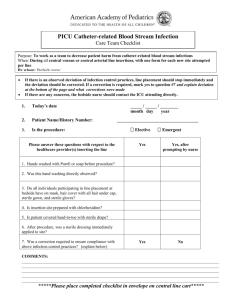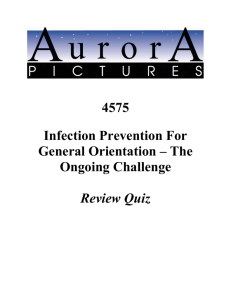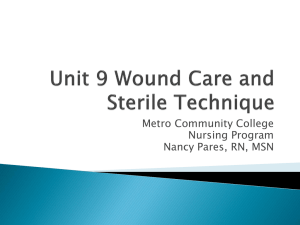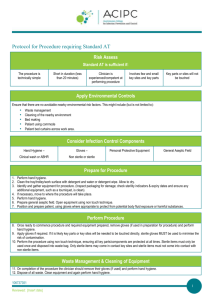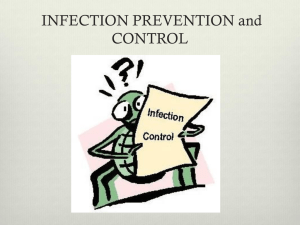Infection control Handout
advertisement
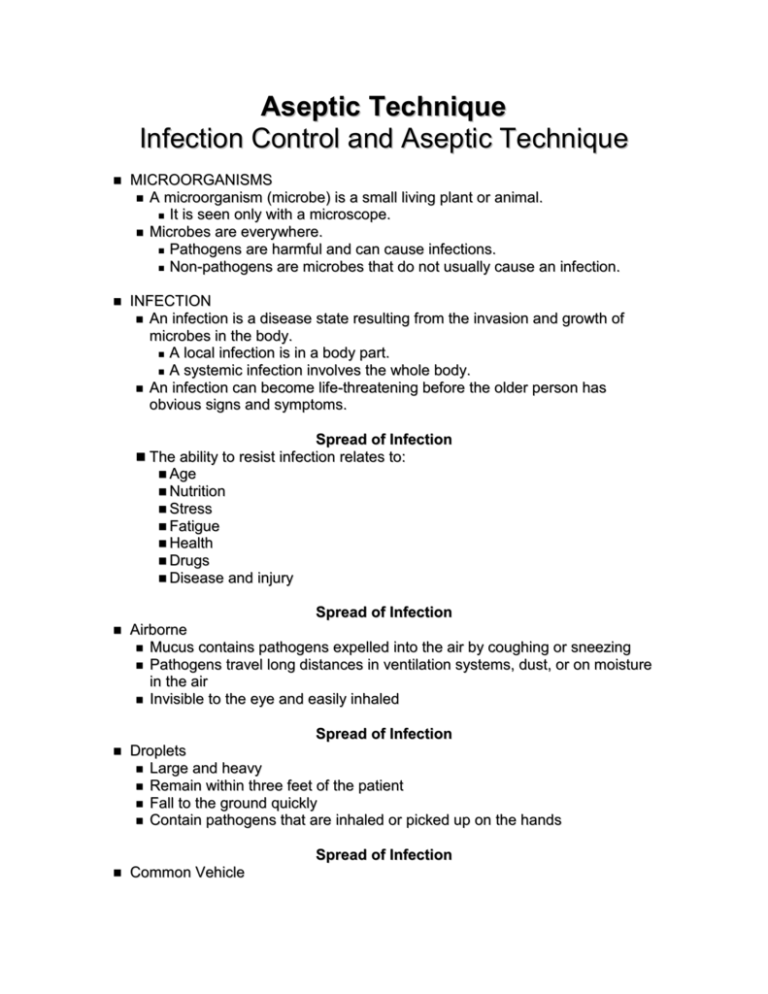
Aseptic Technique Infection Control and Aseptic Technique MICROORGANISMS A microorganism (microbe) is a small living plant or animal. It is seen only with a microscope. Microbes are everywhere. Pathogens are harmful and can cause infections. Non-pathogens are microbes that do not usually cause an infection. INFECTION An infection is a disease state resulting from the invasion and growth of microbes in the body. A local infection is in a body part. A systemic infection involves the whole body. An infection can become life-threatening before the older person has obvious signs and symptoms. Spread of Infection The ability to resist infection relates to: Age Nutrition Stress Fatigue Health Drugs Disease and injury Spread of Infection Airborne Mucus contains pathogens expelled into the air by coughing or sneezing Pathogens travel long distances in ventilation systems, dust, or on moisture in the air Invisible to the eye and easily inhaled Spread of Infection Droplets Large and heavy Remain within three feet of the patient Fall to the ground quickly Contain pathogens that are inhaled or picked up on the hands Spread of Infection Common Vehicle Contaminated food, water, feeding formulas, and equipment used for procedures Pathogens are consumed when eating and drinking Spread of Infection Vectors Insects, rodents, and small animals can carry pathogens and transmit them to humans Chain of Infection Factors necessary for infection to develop Breaking a link in the chain will prevent an infection from spreading Chain of Infection Source Disease-causing pathogen Mode of transmission How the pathogen is spread Susceptible host Person who can become infected Chain of Infection Carrier Infected person who can spread the disease He or she may not know of the infection Portal of entry Place where the microbe enters the body Chain of Infection Portal of exit Secretions, excretions, or droplets in which the pathogens travel when they leave the body Handwashing Most important way to prevent spread of microorganisms. To prevent the spread of microbes, wash your hands: After urinating or having a bowel movement After changing tampons or sanitary pads After contact with your own or another person’s blood, body fluids, secretions, or excretions After coughing, sneezing, or blowing your nose Before and after handling, preparing, or eating food To prevent the spread of microbes, also do the following: Provide all persons with their own linens and personal care items. Cover your nose and mouth when coughing, sneezing, or blowing your nose. Bathe, wash hair, and brush your teeth regularly. W ash fruits and raw vegetables before eating or serving them. W ash cooking and eating utensils with soap and water after use. Hand hygiene Hand hygiene is the easiest and most important way to prevent the spread of infection. Practice hand hygiene before and after giving care. Standard Precautions You cannot tell whether someone has a disease or infection by appearance Standard precautions Used for all patients to prevent infection Involve using personal protective equipment (PPE) when performing certain tasks Standard Precautions Wear gloves when there is contact with: Blood Moist body fluid (except sweat) Secretions Excretions Mucous membranes Nonintact skin Standard Precautions If your gloves become soiled, remove them, wash hands, and apply a new pair We communicate through touch Avoid using gloves for all patient contact Standard Precautions If you are wearing gloves Change them immediately before contacting mucous membranes and nonintact skin Apply a mask and eye protection if there is risk of being splashed with blood or body fluids Standard Precautions A mask may be worn without eye protection, but eye protection should never be worn without a mask Standard Precautions Wear a gown if there is a risk that your uniform may contact blood and body fluids. Select a gown that is fluid resistant Standard Precautions PPE must fit properly If it is cut or torn, it will not protect you, and it should be replaced Restock equipment after use • • • Standard Precautions Avoid contaminating clean equipment, supplies, or surfaces with used gloves Wear a glove on one hand; use the ungloved hand to contact other surfaces Discard gloves in a covered container • • • Standard Precautions Always wash your hands before applying and after removing gloves Never cut, bend, break, or recap needles Discard in a puncture-resistant container Isolation Airborne precautions Used for patients whose disease is spread by the airborne method of transmission Droplet precautions Used for some infections that are spread in the air Isolation Contact precautions Contain pathogens that are spread by direct or indirect contact Usually found in infections of the skin, urine, and fecal material Isolation Special Circumstances Patients with infections transmitted by more than one method Two types of isolation are needed in addition to standard precautions Isolation and standard precautions must be used when working in an isolation room Bioterrorism Bioterrorism Use of biological agents, such as pathogenic organisms or agricultural pests, for terrorist purposes Bioterrorism Your facility will have a disaster plan Provides information for patients, employees, visitors Contains public health protocols to follow in an emergency MEDICAL ASEPSIS Asepsis is being free of disease-producing microbes. Measures are needed to achieve asepsis. Medical asepsis (clean technique) Surgical asepsis (sterile technique) Sterilization is the process of destroying all microbes. Contamination is the process of becoming unclean. SURGICAL ASEPSIS Surgical asepsis (sterile technique) is the practices that keep equipment and supplies free of all microbes. Surgical asepsis is required any time the skin or sterile tissues are entered. If a break occurs in sterile technique, infection is a risk. Sterile Technique A microbe free technique Used for performing procedures within body and during dressing changes Also called surgical asepsis An item or area is sterile if it is free from all microorganisms and spores Flash Sterilization Quick method of sterilizing essential items Risk for contamination is great because personnel are usually rushed Follow manufacturers’ guidelines and facility policies when flash sterilizing Guidelines for Sterile Procedures Always wash your hands before beginning If the sterility of an item is in doubt, consider it unsterile and avoid using it If a sterile item contacts an unsterile item, the sterile item is contaminated Guidelines for Sterile Procedures Consider a sterile package contaminated when: It is cracked, cut, or torn It is wet It has expired Creating a Sterile Field Sanitize and dry the table before placing supplies on it Avoid touching the inside of the package Inside can be used as a sterile field Never turn your back on a sterile field Creating a Sterile Field Avoid crossing over or touching a sterile field. Keep sterile items above waist level Avoid talking, coughing, or sneezing over a sterile field Creating a Sterile Field Use sterile gloves Touch only sterile items Touch only the inside of the package Keep your hands above your waist Avoid touching your clothing or body If sterile gloves touch an unsterile item, they are contaminated. Change the gloves Setting Up a Sterile Field One-inch border around outside edge of the field is considered unsterile Drape hangs over the edges of the table Area below the table is not sterile Sterile supplies can touch only the sterile field Setting Up a Sterile Field Sterile transfer forceps may be used Avoid touching the tips of the forceps Handle is contaminated because you have touched it with your hands
